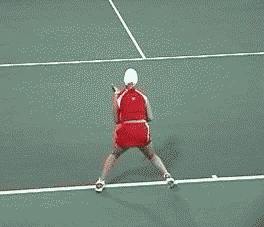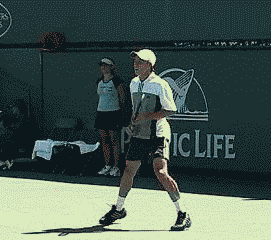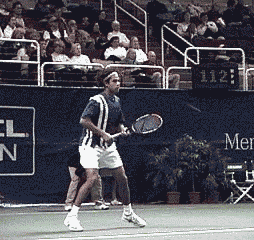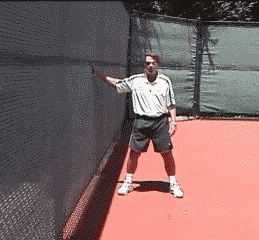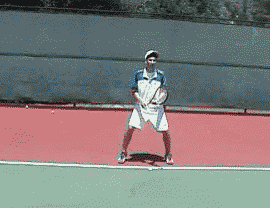|
TennisOne Lessons
Reaction Steps – “How do you move to the ball?” by Jim McLennan Question: From the ready position (or after landing the split step) how does one best move quickly to the forehand (or backhand) for a wide and difficult ball? Said another way. Which foot do you move first, and where?
Three Footwork Sequences There are two distinct movement scenarios on court. Moving to the ball - where the opponent has struck the ball and you move to retrieve it. Recovering - where you hit your shot and recover back to the center, (actually to the midline of the opponent's angle of play on their next shot). There are two options as regards the hips in the above scenarios. As you move (either to the ball or to recover) the hips can face the net, lateral motion, or the they can turn toward the direction of the movement, forward motion. Forward motion occurs when we walk or run, lateral motion occurs when we sidestep, or shuffle. There are three footwork sequences to initiate movement. If moving to a forehand, one can pivot on the right foot and quickly crossover (forward motion) with the left foot. One can move the right foot quickly toward the ball then follow with the left, aka the jab step (lateral motion). And one can turn the hips and move the right foot quickly away from the ball, following with the left, known as a gravity turn (forward motion). Your choice of footwork sequence depends on how far and how quickly you must move. And indeed, tennis professionals use all of the above methods in selected instances.
Moving to the ball Lateral motion occurs when the hips face the net (instead of the ball). Forward motion occurs when the hips turn and face the direction of movement (the ball). The crossover step leads with the left foot first, the pivot creates forward motion. The jab step or side shuffle, leads with the right foot out toward the ball, creating lateral motion. The gravity turn or drop step, drops the right foot away from the ball as the hips turn, creating forward motion. The difference involves the relationship of the initial step to the center of gravity. The crossover step strikes the ground beneath or beyond the center of gravity (balance), the jab step strikes the ground beyond the center of gravity (balance), and the gravity turn or drop step strikes the ground behind the center of gravity (dynamic imbalance). Paradigm When I posed the following question to a group of tennis professionals at a national tennis conference, “What is the quickest and/or least effortful way to move for a wide and difficult ball?” About 90% chose the jab step, less than 10% chose the crossover step, and from an audience of 200 only a handful chose the drop step. Furthermore, footwork drills in national tennis magazines tell a similar story. Horizontal repeaters: “Holding a racquet, stand on the far left corner of the court, facing the net, side step to the middle and back to the left corner, then sprint to the right corner, repeat the drill from the right side.“ The side shuffle with forward sprint drill, “Moving with either a shuffle or crossover step to get to the ball, and to alternate methods on subsequent repetitions.” And finally, “Tennis is a lower body sport … it takes a lot of power to run to the ball.”
Some Background I played college tennis, played the satellite circuit, and have held national and sectional rankings. So with that background in mind, I was playing a tournament in New Orleans in 1977, and after a match I was approached by a man who told me, “You are pretty good for someone who can't run.” As he walked away I noted his artificial leg. This is true. I met him again some months later. He was Don Kerr, at that time the tennis coach at Tulane, but among many other things he was also a linguist, physical therapist, badminton expert and much much more. Over the years we worked closely on many projects, but it all started with his observations of my footwork, and I suppose, my openness to experiment with his ideas. In 1933 he had written about and began promoting an idea he called “gravity motion” where the footwork movements were designed to enable gravity to initiate motion. In this model, gravity got you started, then once started you used your legs and musculature to either keep going and or to accelerate even faster. The training all had to do with the hips and the first step. Facing the net he wanted a hip turn toward the ball that would simultaneously move the foot closest to the ball in the opposite direction, and when done correctly there would be an immediate falling or surging move to the ball, at which point the feet followed.
When he said I couldn't run, what he meant (which I was unaware of at the time) was that my initial jab step (yes I was a shuffler) was similar to how amputees first relearn to walk – in that a limp is actually the amputee stepping past their center of gravity with their good leg (so they cannot lose balance and fall) and then dragging their prosthesis behind them. Don trained me and willing amputees, to take an initial negative step where the center of gravity immediately moved past the base of support, and then the feet quickly followed beneath rather than beyond the body. As you read this (probably incredulously) consider that whenever anyone bumps into a plate glass door, do they hit their foot, their knee or their head? Always their head, implying that walking is a process where the body is imbalanced slightly in the direction of movement and the feet trail. But with the on court jab step the feet precede instead of trail. The reason this does not appear to be a limp (to the untrained eye) is that the move is practiced and the athletes use their musculature and training to overcome any inherent awkwardness in this shuffling step. Case for the Gravity Turn John Bunn, Scientific Principles of Coaching, “To start quickly in one direction (to the ball) keep the center of gravity as high as possible and as near as possible to the edge of the base nearest the direction of intended motion. This position of least stable equilibrium …takes advantage of the force of gravity in speeding the starting movement.”
In order to create this dynamic imbalance from the ready position, one moves the center of gravity past the base of support. The jab step and the crossover step do not, and inadvertently emphasize the need for subsequent muscular power and explosiveness. On the other hand, the drop step instantly moves the center of gravity beyond the base of support. Study Fred Perry in the Kings of the Court video, examine the volleying footwork of Edberg and McEnroe, all rely on an initial drop step when moving quickly to the ball. And in each instance the moves appear nimble rather than powerful. Essence the Gravity Turn A wide ready position stance (the wider the better). After reading the ball, the following three actions occur.
Practicing the Gravity Turn Experiment with the feel of dynamic imbalance. Stand alongside a wall, shoulders aligned at a right angle to the wall, positioned so you can barely reach the wall with the right hand (right-hander moving to the forehand). Spread your feet, this wide base of support (BS) balances the center of gravity (CG). Lift the right foot off the ground. At this moment you either rebalance, shifting your CG over the left foot (BS), or fall toward the wall (remember to catch yourself with the outstretched arm). Gravity induces the movement without muscular force. Similarly, gravity can initiate the force that overcomes resting inertia, and start you to the ball. When learning or teaching this move on court, the trick is not to reposition as you drop the leading foot, but rather learning to feel the subtle “fall.” On-court Training The mover stands on the baseline, in the ready position, with the baseline center mark exactly between their feet. The teacher faces the mover, standing 15 feet away. The teacher looks for a quarter hip turn (90-degree) toward the direction of movement, and a simultaneous drop step placed on the baseline near the baseline center mark. The hip turn and drop step positions this foot parallel to the baseline. As the mover practices the start, the teacher looks for quickness and ease of movement. In a variation, the teacher claps her hands and quickly points left or right. The mover practices gravity turns to the forehand or backhand depending on where the teacher points. The clap resembles the ball contact, and the pointing to one side or the other immediately after the clap approximates the player reading the direction of the ball. Key words the teacher may use to assist the training include; wide stance, posture, stand tall, turn to start, turn the hips then move the feet, drop step with the turn.
“Go” is a more advanced drill. The player assumes a wide ready stance, and begins a quick, rat-a-tat-tat footwork, moving in place, left-right-left-right. The teacher calls out a tempo and sequence the player follows. As the player continues moving in place, wide stance, alternating left and right foot strikes, the coach prepares to signal movement with a clap and an immediate pointing either right or left. Now the fun begins. Carefully watching, just prior to a left-footed landing, the coach claps and points for movement to the player's right. When done correctly, the player will be able to land on the left foot and perform a gravity turn to the right. No matter what your age or skill level, the gravity turn enhances agility, enables quickness and ease of movement. It is admittedly counter intuitive, but examples are easily seen in nearly all sports where quickness is required – soccer goalies, baseball infielders, and especially running backs in the open field. Note: For those who are interested in a deeper understanding of the science behind the gravity step, click here to see a more technical explanation. Your comments are welcome. Let us know what you think about Jim McLennan's article by emailing us here at TennisOne.
|
||||||||||||||

